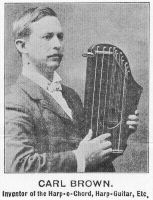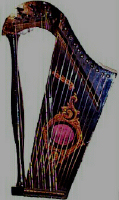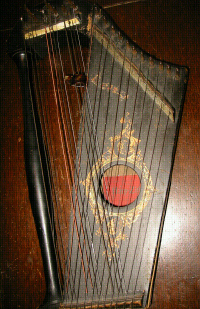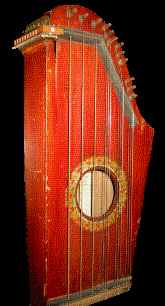
|
|
My Harp-O-Chord
|

|
An unusually chatty soundhole
label. Click on picture for
closeup of the label. |
|
I have bought most of my instruments on Ebay, but this one
just came to me. Actually, it was given to me by one of my daughter's friends,
who had noticed the zithers all over the walls and thought to himself -
"Aha! Someone who would appreciate that bizarre instrument that we found
in the basement!"
I thanked him politely and turned the thing over in my hands for awhile,
trying to figure out why there was a funny rectangular hole near on one
side, right under the curved top. I kept thinking a piece was missing.
It wasn't until I started reading the soundhole label that it finally hit
me, and I started jumping around yelling, "A Harp-O-Chord! I can't believe
it, it's a real Harp-O-Chord!"
I even went out and bought a harmonica in the key of G so I could try
it out. This thing is a hoot to play, although it's hard to imagine audiences
being spellbound by it for as long as Mr. Brown apparently envisioned.
It's simple enough to play: you play the melody on the harmonica, and
strum the 3 basic chords in accompaniment. The strings are arranged in
an unusual fashion for a chord zither; the bass strings for each chord
are separated from the chords themselves. This is actually very clever,
making it easy to hit the bass string with the thumb and then strum the
rest of the chord with the fingers. This is an important consideration,
since the performer cannot actually see the strings while blowing into
the harmonica.
What makes it such an unforgettable experience (for the musician, anyway)
is the way the bass notes of the chords vibrate your lips and resonate
in your teeth. It's not just the soundbox of the zither that becomes an
amplifier for the harmonica - your entire head is turned into an amplifier!
I'm sure that most of this effect is lost on the listener, but let's face
it, listeners aren't likely to stick around very long once they stop laughing. |
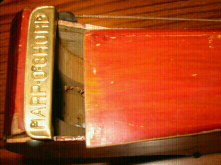
|
|
What's that gaping hole?
|
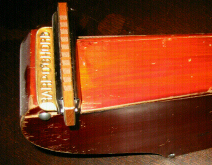
|
Ah, that's better!
A Harp-O-Chord fulfilled! |
|
